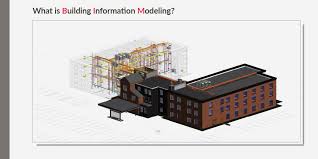Exploring Building Information Modeling
Building Information Modeling (BIM) is revolutionizing the way construction projects are planned, designed, and executed. It is a digital representation of the physical and functional characteristics of a building or infrastructure.
BIM allows architects, engineers, and construction professionals to collaborate more effectively throughout the entire lifecycle of a project. By creating a 3D model that contains detailed information about every aspect of the building, stakeholders can make informed decisions and identify potential issues before construction begins.
One of the key benefits of BIM is its ability to improve communication and coordination among project teams. With all stakeholders working from a single, shared model, conflicts and errors can be identified and resolved early on, leading to cost savings and improved project outcomes.
Furthermore, BIM enables better visualization of the final product, allowing clients to have a clearer understanding of the design intent and make more informed decisions. This can result in buildings that better meet the needs of their users and are more sustainable and energy-efficient.
In addition to its benefits during the design and construction phases, BIM also offers advantages during the operation and maintenance of a building. The detailed information stored in the model can be used for facilities management, renovations, and future expansions.
As technology continues to advance, BIM is evolving to incorporate new features such as virtual reality simulations, artificial intelligence algorithms, and cloud-based collaboration tools. These innovations are further enhancing the capabilities of BIM and its potential to transform the construction industry.
In conclusion, Building Information Modeling is a powerful tool that is reshaping how buildings are designed, constructed, and managed. Its ability to improve collaboration, reduce errors, and enhance decision-making makes it an essential component of modern construction projects.
Understanding BIM: Key Differences, Uses, Examples, and Levels Explained
- What is the difference between BIM and CAD?
- What is BIM used for?
- What is an example of a BIM?
- What are the 5 levels of BIM?
What is the difference between BIM and CAD?
When considering the difference between Building Information Modeling (BIM) and Computer-Aided Design (CAD), it’s important to understand that while both are digital tools used in the architecture, engineering, and construction industries, they serve different purposes. CAD primarily focuses on creating 2D or 3D geometric representations of a design, allowing for precise drafting and detailing. On the other hand, BIM goes beyond geometry to include additional information about the building elements and their relationships, such as materials, costs, and performance data. BIM enables a more comprehensive and collaborative approach to building design and construction by providing a holistic view of the project throughout its lifecycle, from initial concept to operation and maintenance.
What is BIM used for?
Building Information Modeling (BIM) is commonly used for a wide range of purposes in the construction industry. Its primary function is to create a digital representation of a building or infrastructure project, incorporating detailed information about its physical and functional characteristics. BIM is utilised for collaborative design and planning, enabling architects, engineers, and construction professionals to work together more efficiently. It helps in visualising the project, detecting clashes or conflicts early on, improving coordination among stakeholders, enhancing decision-making processes, and ultimately leading to cost savings and better project outcomes. Additionally, BIM is employed for facilities management, renovations, and future maintenance of buildings due to the wealth of data stored within the model.
What is an example of a BIM?
An example of a Building Information Modeling (BIM) project is the construction of a new sustainable office building in a city centre. In this scenario, the BIM model would contain detailed information about the building’s design, materials, structural components, and systems such as HVAC and electrical. Stakeholders involved in the project, including architects, engineers, contractors, and clients, would use the BIM model to visualise the building in 3D, identify potential clashes or issues early on, and make informed decisions throughout the construction process. The BIM model would also store data about energy efficiency measures, maintenance schedules, and future renovations to ensure the building remains sustainable and functional over its lifecycle. This example illustrates how BIM can streamline collaboration and improve project outcomes in complex construction projects.
What are the 5 levels of BIM?
In the realm of Building Information Modeling (BIM), the concept of different levels plays a crucial role in understanding the maturity and sophistication of BIM implementation. The 5 levels of BIM, often referred to as BIM maturity levels, provide a structured framework for assessing an organization’s proficiency in utilising BIM technology. These levels range from Level 0, where no collaboration or shared digital data exists, to Level 3, which involves full collaboration and integration of all project information in a shared digital space. Each level represents a progression towards more advanced BIM practices, ultimately aiming to enhance efficiency, communication, and decision-making throughout the lifecycle of construction projects.

No Responses